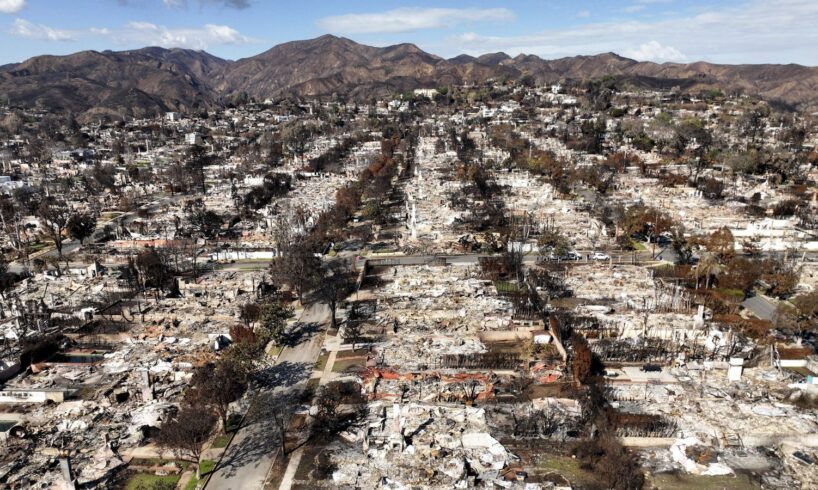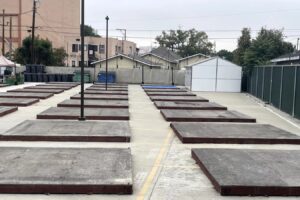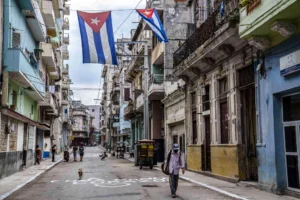
This undated photo provided by the US Attorney’s Office shows Jonathan Rinderknecht, a suspect in the Palisades Fire. [AP Photo/US Attorney’s Office]
On October 8 federal prosecutors announced the arrest of 29-year-old Jonathan Rinderknecht, charging him with igniting a small New Year’s Day blaze—the Lachman Fire—that investigators claim smoldered unseen in roots before reemerging days later as the catastrophic Palisades Fire, which killed a dozen people and destroyed thousands of homes.
The U.S. Attorney’s Office for the Central District of California, led by Acting U.S. Attorney Bill Essayli, presented an affidavit as the case’s factual spine. Media outlets dutifully reproduced the story: an intentional ignition on January 1, apparent suppression, subterranean smoldering, and then a wind-driven resurging conflagration on January 7 that became the disaster everyone remembers.
The devastation from the Palisades Fire is shown in an aerial view in the Pacific Palisades neighborhood of Los Angeles, Monday, January 27, 2025. [AP Photo/Jae C. Hong]
At first glance the story has all the ingredients of a straightforward criminal case: a suspect allegedly at the scene, digital traces and surveillance tying him to the site, and forensic conclusions that link the later, larger fire to the earlier burn.
Investigators claim they located the Palisades origin at a burned root structure just outside the handline, a manually constructed firebreak cleared of vegetation to slow or stop a blaze, from the Lachman incident and that a “firebrand” smoldered in dense vegetation until winds turned it into open flame. They assert having ruled out other causes such as lightning, power-line failure, or a fresh ignition on January 7.
Yet the central forensic claim—that a holdover underground smolder persisted unseen for six days before resurfacing—is far from scientifically demonstrated. The complaint describes photos, site visits, and “investigative judgment,” but it offers no continuous thermal data proving combustion through the interval. No heat-signature time series, soil-temperature logs, or repeated infrared imagery have been released—only conclusions.
Smoldering in roots and duff is a real physical phenomenon. Fire scientists have long shown that organic matter can glow underground for days under the right conditions. The hypothesis is plausible, but plausibility is not proof. The prosecution’s case rests on a mosaic of inferences, scene patterns and exclusions, rather than a transparent sequence of public laboratory measurements. That distinction matters when one person is being blamed for a disaster with vast social and economic consequences.
The official narrative does more than point a finger at an alleged arsonist. It also implicitly blames the fire department for failing to detect or mop up smoldering hotspots. In statements released alongside the arrest, the Los Angeles Fire Department emphasized the traumatic toll of the blaze and released an after-action review of the initial response.
Critics quoted in the press have said the affidavit could just as easily be read as pointing to gaps in post-suppression monitoring, shortages of staff and resources, and a decayed emergency infrastructure during the wind event that followed. In short, the fixation on a lone arsonist both criminalizes an individual and shifts attention onto firefighting tactics and capacity, where accountability meets budget constraints and political choices about emergency funding.
The fixation on a lone culprit also serves to divert attention from political responsibility. Both major parties share it. For decades, Democratic and Republican administrations alike have gutted public prevention budgets while shielding private utilities and insurers.
In California, where Democrats dominate every lever of government, this responsibility is especially stark.
State leaders repeatedly blocked or diluted oversight of Pacific Gas & Electric and Southern California Edison, whose neglected equipment has caused repeated infernos. They allowed insurance giants like State Farm to profit from the crisis—charging higher premiums, denying claims, and then withdrawing coverage—while presenting these decisions as “market corrections.”
Private equity firms have been facilitated and allowed to monopolize the supply of fire trucks. The decay of the fire department, the neglect of grid infrastructure, and the absence of affordable insurance are all political outcomes, not natural accidents.
The “blame the arsonist” story criminalizes an individual while obscuring the bipartisan dismantling of public safety capacity. If the catastrophe can be reduced to the actions of one man, then litigation stays narrow and the structural causes—aging utilities, deregulated insurance, climate change, and state negligence—are removed from scrutiny.
The January fires across the Los Angeles region have exposed exactly those causes. Investigations into the Eaton-Altadena complex found evidence of malfunctioning distribution lines and dispatch failures. Utility corporations, backed by state regulators and their Democratic patrons, will fight hard to keep their negligence out of the official story.
The economic angle is blunt and real. When a wildfire becomes framed as arson it gives insurers legal room to delay and contest claims. California’s insurance system has already been roiled by mass withdrawals from private insurers, a swollen FAIR Plan, and litigation over denials and restrictive interpretations for smoke and contamination claims.
Lawsuits filed against insurers and investigations by regulators show how the post-disaster legal architecture is fertile ground for denial, delay and reduced payouts, even as reconstruction contracts flow to contractors and developers who profit from the disaster economy. In that sense a scapegoat arson narrative protects corporate balance sheets and preserves the social conditions under which private profit from catastrophe continues apace.
There is a political face to this operation too. The federal arrest was announced by Trump loyalist Bill Essayli, the acting U.S. attorney for the Central District of California, installed by Attorney General Pam Bondi and kept in power by Trump through a maneuver that circumvented Senate confirmation.
Essayli’s tenure has been marked by a highly politicized posture: his office has aggressively pursued protest cases tied to immigration raids, even as countless indictments faltered or were dismissed and several career prosecutors resigned in protest after Essayli intervened to offer an unusually lenient post-trial plea to a convicted sheriff’s deputy.
Before taking office as a federal prosecutor, Essayli served as private counsel to figures associated with the January 6 events, including Alan Hostetter, a former police chief convicted of four felonies, including conspiring to obstruct Congress, in connection with the attempted coup. Hostetter breached the Capitol with a hatchet in his backpack and later posted on social media from the upper west terrace of the building, “This was the shot heard round the world!…the 2021 version of 1776. That war lasted 8 years. We are just getting started.”
In court filings and interviews Essayli disputed the government’s narrative of organized violence and tried to frame defendants’ actions as protected First Amendment activity.
Even if Rinderknecht were found guilty, it would change nothing about the state’s scapegoating operation or the political function it serves: diverting attention from systemic responsibility.
More broadly, disasters are never the work of one individual. They are produced by social relations and political priorities. Wildfires in California expose class inequality: who can afford insurance, who can evacuate, who profits afterward. In West Altadena, those who died lived in neighborhoods long deprived of emergency resources. The Democrats who govern California are primarily responsible for that reality through deregulation and their alliance with corporate energy and finance.
To focus public anger on one supposed arsonist is to perform the oldest function of capitalist politics: scapegoating to conceal social crime. It protects the ruling class, diverts rage from the corporations and bureaucracies that profit from catastrophe, and legitimizes further repression.
The only genuine safeguard against such tragedies is not sensational prosecution but massive public investment and democratic control: publicly owned, modernized utilities; a universal, non-profit insurance system; fully staffed fire departments; and internationally coordinated planning for a warming climate. In a word, socialist measures, grounded in human need, not private accumulation.
Sign up for the WSWS email newsletter





